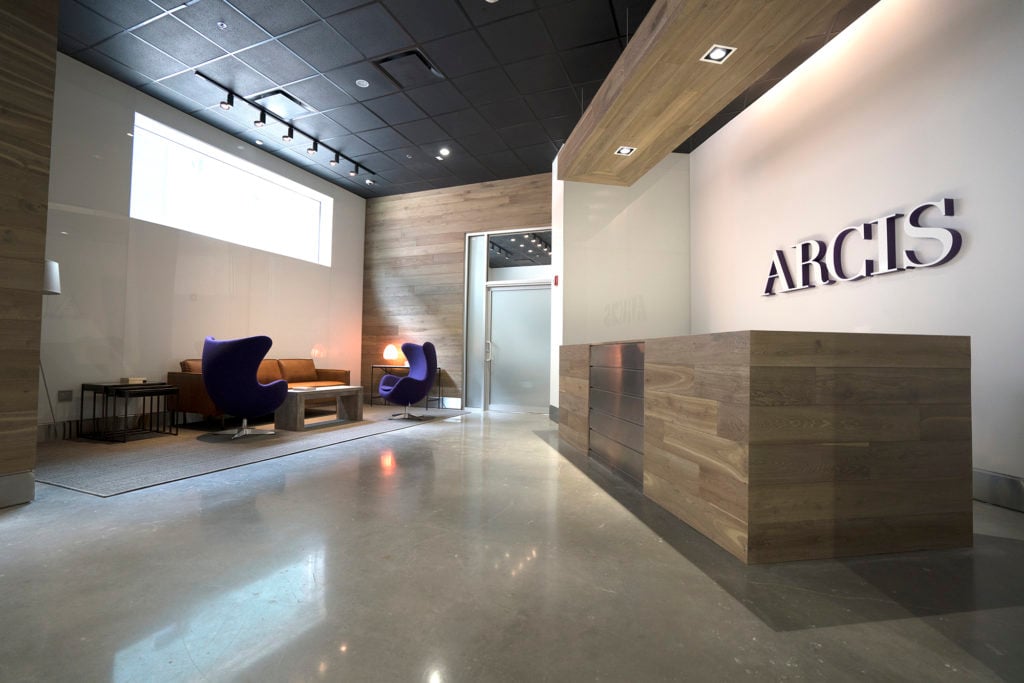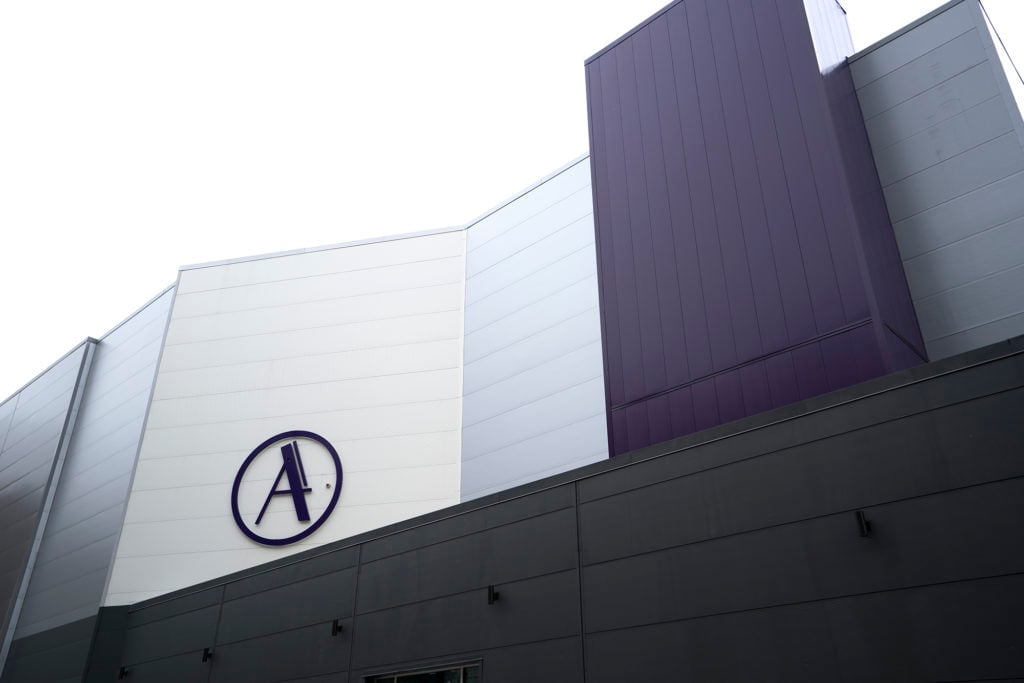Market
Inside the Uber-High-Tech Art Warehouse That Doubles as New York’s First-Ever Freeport
artnet News gets a sneak peek inside ARCIS, a new high-tech art storage facility that would even give 007 problems.

artnet News gets a sneak peek inside ARCIS, a new high-tech art storage facility that would even give 007 problems.

Eileen Kinsella

ARCIS, the world’s newest freeport, isn’t just high-tech—it’s like something out of a Bond movie.
Visitors to the fortress-like building must submit to an iris scanner, followed by a vascular scanner, while waiting in a mechanized holding vestibule—and that’s just to get to the greeting desk. Once inside the serene, hotel-like lobby, an ARCIS official must check the visitor’s government-issued ID before issuing a temporary access badge—whether it’s the first visit to the facility or the 50th. It’s all part of standard security to be in a space where hundreds of millions—if not billions—of dollars worth of fine art and cultural property will eventually be stored.

Exterior of ARCIS. Image courtesy of ARCIS ©2018.
Where is this futuristic art fortress? Geneva? Luxembourg? Singapore? Try Harlem.
ARCIS, which is owned by real estate giant Cayre Equities, recently opened on a quiet street in Upper Manhattan, across from a block-long Metropolitan Transit Authority bus depot. If the location is surprising, the building’s legal status is even more striking. The custom-built, five-story, 110,000-square-foot warehouse has been designated a foreign trade zone (or FTZ), the business equivalent of a winning lottery ticket as far as art warehouses go.
Translation? New York City, the putative capital of the art world, now has its very own freeport for duty-free art storage.
This will likely be welcome news to many New York collectors, particularly as the Manhattan District Attorney continues to crack down on galleries and collectors for tax evasion. The FTZ designation creates a kind of country-less zone, according to the US Customs and Border Protection website. Once you’ve stepped off 146th street and inside the ARCIS building, you’ve officially left the United States. (And there are a plethora of signs tacked up to the outside the building to remind you, promising fines of up to a quarter of a million dollars and up to 10 years in prison for trespassers.)
ARCIS isn’t the first player in this game. In late 2016, veteran shipper Fritz Dietl launched a Delaware freeport, which widened the options for collectors hoping to avoid having to ship works out of the country to avoid taxes. ARCIS is hoping to follow that blueprint, but with loads of high-tech perks.
In addition to the tax advantages of storing artwork in ARCIS’s freeport, the new building offers art transport, climate-controlled storage spaces, and fire, flood, and theft protection systems that are among the most cutting-edge in the world. In much of the building, the air is changed between three to six times an hour, depending on activity in the space. Padlocks to individual storage spaces are kept in a “21st-century key control box” that tracks every movement of a key.
ARCIS executive director Tom Sapienza and director of operations Kevin Lay drew on the expertise of engineers involved in constructing the new Whitney Museum in New York, as well as the Van Gogh Museum in Amsterdam. So, what prompted such an ambitious undertaking?
“One of the things that’s extraordinary about this building is that it was built post-Hurricane Sandy and at a time when the art market has exploded,” Lay explains. “In the 25 years that I’ve been doing this, it’s just astonishing that what used to be commonly available at commercial galleries now constitutes premiere auction lots,” he says, noting the uptick in seven-, eight-, and even nine-figure prices in recent years. “We’re here to protect that.”
“This facility is outside the post-Sandy flood zone and the surge zone,” Sapienza says. “That’s something that was very important to the underwriters.” (Indeed, “underwriters love that” was a common refrain from Lay and Sapienza during my guided tour of the facility.)
The backup generator, which runs on natural gas as opposed to diesel, is capable of operating 100 percent of the building at any time. The generator setup also gives ARCIS the ability to switch seamlessly between electric and natural gas power. That could come in handy during power outages, according to Lay. “Climate change is real, no matter what the politics are. People are expecting hotter summers,” he says. “Let’s say Con Edison needs us to come off the grid at any moment, such as a brownout situation. We could do that without any risk.”
The ARCIS leaders expect the building to earn both LEED and BREAM certifications. That’s because the structure, they say, goes above and beyond the organizations’ checklists for environmental friendliness. The humidity control system, for instance, involves a process called “atomization,” or reverse osmosis, which filters regular tap water, then dechlorinates and softens it. “We use reverse osmosis so we have pure water in this tank,” he says, gesturing at a futuristic set up in one of the mechanical rooms. “This atomizer crushes the water at a molecular level and distributes it into the building for humidity.”
The process has a significant impact on energy use, which lowers costs. Sapienza says that steam humidity that costs $100 is $10 using atomization. “That’s a big contributor to our LEED and BREAM certification—our lower energy use,” he adds.
Aside from all of the green features and technical wizardry, the building also facilitates the showing of artwork. Clients can take advantage of five viewing rooms on the building’s first floor. These vary in size, but all look like Chelsea galleries with poured concrete floors and plywood backed walls. ARCIS’s team of art handlers—all of whom have been hired by word of mouth, according to Lay—can customize display and lighting as needed. The LED lights, a requirement in all new New York City buildings, can be arranged to “the exact spectrum that we need and with interchangeable lenses,” Lay says. (The special bulbs cost $1,000 each; ARCIS has 100 of them.)
At nearly 1,000 square feet, the largest viewing room also boasts a two-ton sculpture hoist on a trolley. “Not only could I hang a Calder up on that—which is fantastic—but this allows you to bring the hook down so you can hang it at waist level and then very gently raise it up,” Lay boasts.
Aside from the standard viewing rooms, there’s also an “aperture” room on the first floor, a small-office size chamber which has its own floor-to-ceiling sliding door. Sapienza and Lay realized the space was too valuable not to offer. “We can rent this room,” Lay says. “[Galleries] can put their registrar in here with a room full of artworks and laptop computer, and this is like an office.” That way, he says, “they don’t have to pay the big price of a viewing room”—a plus in the age of the “virtual” dealer or those without permanent gallery space.
While there is little doubt that ARCIS offers a state-of-the-art option for storage, just how much the FTZ tax break will save collectors—or whether the savings will offset the costs of using the facility—is unclear. The facility’s FTZ designation “has only limited use in the art world,” cautions Dietl, the rival founder of the Delaware freeport. In a phone interview with artnet News, he explained that “the fact that Delaware is one of the few states with no sales or use tax is actually much more important and useful to many of our clients. The moment I see a useful application for our clients for a FTZ in NYC, I will certainly create an outpost for the Delaware Freeport in New York.”
And as for ARCIS costs, Sapienza and Lay would only say that they are “within market”—and that viewing rooms cost you extra.
“We’re not really selling price,” Lay says. “We’re selling the science that went into this building.” And to be sure, that science doesn’t come cheap.